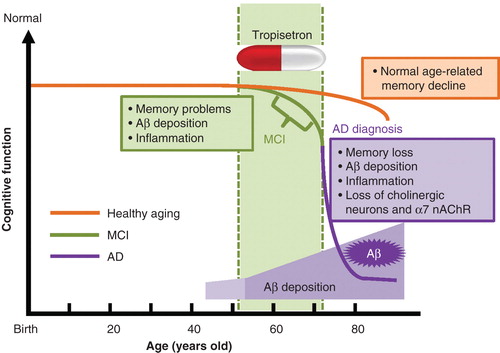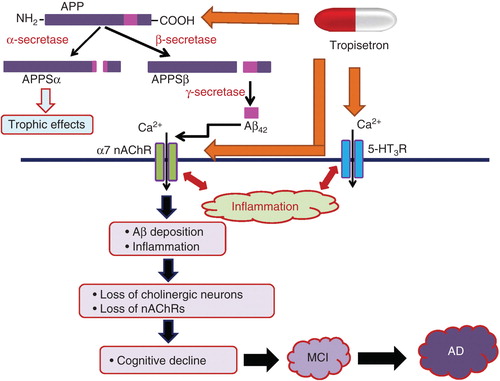Figures & data
Figure 1. The life course in healthy aging, MCI subjects and AD patients. As people grow older, healthy subjects develop age-related memory loss. Subjects with MCI develop a greater degree of memory problems relative to age-matched healthy subjects, although they do not experience the personality changes or other problems characteristic of AD. Studies using PET showed that Aβ deposition and inflammation are present in the brains of MCI subjects. AD patients suffer severe memory loss, Aβ deposition, inflammation and loss of cholinergic neurons and α7 nAChRs. The deposition of Aβ in the brain starts before MCI and increases with age. Therefore, tropisetron could potentially prevent the onset of AD if administered during or before the onset of MCI.

Figure 2. Schematic diagram of the proteolytic events and cleave products associated with APP and possible mechanistic action of tropisetron in the prevention of AD. APP is metabolized by a membrane-associated protease, α-secretase, and this cleavage releases the extracellular amino-terminal ectodomain of APP (APPSα), which displays trophic properties. The alternative cleavage pathway involves two sequential cleavages by β- and γ-secretase and gives rise to a series of Aβ. Accumulating evidence suggests that the interaction between Aβ peptides and α7 nAChRs is integral to the pathology of AD. The interaction between Aβ peptides and α7 nAChRs might induce Aβ deposition and inflammation in the brain, resulting in the loss of cholinergic neurons and α7 nAChR. These neurotoxic events may promote cognitive decline, followed by MCI, and ultimately lead to AD. In combination with an α7 nAChR agonist and serotonin 5-HT3 receptor antagonist, tropisetron, binds to APP, with a sub-micromolar affinity. The interaction of tropisetron with 5-HT3 receptors also plays a role in the anti-inflammatory and neuroprotective effect against Aβ-induced neurotoxicity. Taken together, tropisetron could act as a potential therapeutic drug for AD, if be administered during the period of MCI or early stages of AD.


